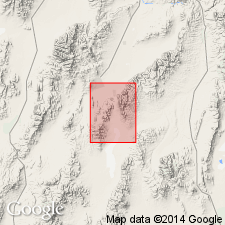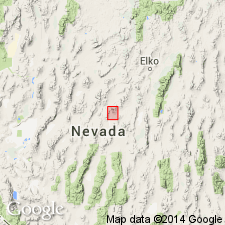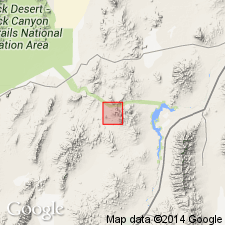
- Usage in publication:
-
- Caetano Tuff*
- Modifications:
-
- Named
- Geochronologic dating
- Mapped
- Dominant lithology:
-
- Tuff
- Conglomerate
- Sandstone
- AAPG geologic province:
-
- Great Basin province
Summary:
Pg. 73-78, pI. 1 (geol. map), pl. 2 (fossil locs.). Caetano Tuff. Name applied to body of welded and water-laid tuff and associated conglomerate and sandstone. Thickness about 8,000 feet on aasumption that formation is almost completely duplicated by normal faulting. Only exposure of base of formation is southwest of Francis Cabin, 2 miles north of Caetano ranch house. Here a normal fault has brought up a mass of quartzite of the Valmy Formation about 0.5 mi long. Age is considered Oligocene(?); sample yielded a K-Ar age of 31.5 Ma (G.H. Curtis, Univ. Calif.-Berkeley, written commun. 1961). Age is controversial; pollen collected from interbedded water-laid tuffs indicate a Miocene or older age (Leopold, USGS, written commun., 1960), and vertebrates and invertebrates collected from similar rocks in the Shoshone Range indicate a Miocene or early Pliocene age (Gilluly and Gates, USGS Prof. Paper 465, p. 88-89). Report includes geologic map, chemical analyses.
Crops out over most of the northern Toiyabe Range north of Wenban fault and south of Cortez Canyon, Cortez 15-min quadrangle, Lander Co., northern NV. Named from Caetano Ranch, in sec. 20, T. 26 N., R. 47 E., east Lander Co., NV, which is situated on and surrounded by the formation.
Source: Publication; US geologic names lexicon (USGS Bull. 1350, p. 109); GNU records (USGS DDS-6; Menlo GNULEX).

- Usage in publication:
-
- Caetano Tuff*
- Modifications:
-
- Age modified
- Geochronologic dating
- AAPG geologic province:
-
- Great Basin province
Summary:
Consists of phenocrysts of pink to smoky quartz, sanidine, biotite, plagioclase, and lithic fragments in pinkish-gray to purple-gray matrix of welded glass shards. New K-Ar determinations on biotite and sanidine from sample of Caetano Tuff yielded ages of 34.4 +/-1 Ma and 32.6 +/-1.0 Ma. Armstrong (1970) reported 30.6 Ma on chloritized biotite from sample collected just south of upper plate of Roberts Mountain thrust, roughly 0.5 mi east of Crescent fault and an age of 31.2 Ma from whole-rock sample collected about 1 mi east of Caetano Ranch, 5 mi southwest of Cortez. Assigned age is Oligocene.
Source: GNU records (USGS DDS-6; Menlo GNULEX).

- Usage in publication:
-
- Caetano Tuff*
- Modifications:
-
- Areal extent
- AAPG geologic province:
-
- Great Basin province
Summary:
Mapped in southern Tobin Range, Pershing County, NV. Consists of 300 ft of rhyolitic ash-flow tuff. K-Ar determination on sanidine from welded tuff gave Oligocene age of 33.6 +/-1.1 Ma (McKee and others, 1971).
Source: GNU records (USGS DDS-6; Menlo GNULEX).
For more information, please contact Nancy Stamm, Geologic Names Committee Secretary.
Asterisk (*) indicates published by U.S. Geological Survey authors.
"No current usage" (†) implies that a name has been abandoned or has fallen into disuse. Former usage and, if known, replacement name given in parentheses ( ).
Slash (/) indicates name conflicts with nomenclatural guidelines (CSN, 1933; ACSN, 1961, 1970; NACSN, 1983, 2005, 2021). May be explained within brackets ([ ]).

